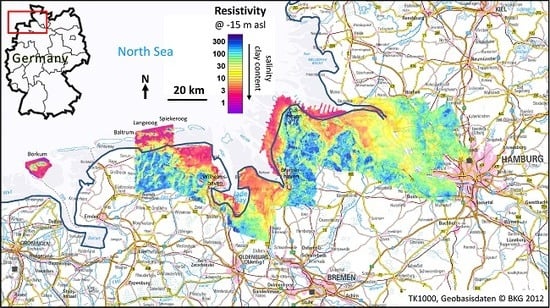Airborne Electromagnetic, Magnetic, and Radiometric Surveys at the German North Sea Coast Applied to Groundwater and Soil Investigations
Abstract
:1. Introduction
2. Study Area German North Sea Coast
3. Airborne Geophysical Data
3.1. Survey Systems
3.2. Survey Areas
3.3. Data Processing
3.3.1. Position Data
3.3.2. Electromagnetic Data
3.3.3. Magnetic Data
3.3.4. Radiometric Data
4. Results
4.1. General Results
4.1.1. Results of Electromagnetics
4.1.2. Results of Magnetics
4.1.3. Results of Radiometrics
4.2. Specific Aspects
4.2.1. Freshwater Lenses on Islands
4.2.2. Seawater Intrusion
4.2.3. Submarine Groundwater Discharge
4.2.4. Buried Valleys
4.2.5. Historic Landscapes
4.2.6. Peatlands
5. Discussion
5.1. Accuracy of Airborne Results
5.2. Estimation of Boundaries from Airborne Data
5.3. Utilization of Airborne Results
6. Conclusions
Supplementary Materials
Author Contributions
Funding
Acknowledgments
Conflicts of Interest
References
- Post, V.E.A.; Eichholz, M.; Brentführer, R. Groundwater Management in Coastal Zones; Bundesanstalt für Geowissenschaften und Rohstoffe (BGR): Hannover, Germany, 2018; pp. 1–107. Available online: https://www.bgr.bund.de/EN/Themen/Wasser/Produkte/Downloads/groundwater_management_in_coastal_zones.pdf?__blob=publicationFile&v=3 (accessed on 19 February 2020).
- Kirsch, R. (Ed.) Groundwater Geophysics—A Tool for Hydrogeology, 2nd ed.; Springer: Berlin/Heidelberg, Germany, 2009; pp. 1–548. [Google Scholar] [CrossRef]
- Rubin, Y.; Hubbard, S.S. (Eds.) Hydrogeophysics, 1st ed.; Springer: Dordrecht, The Netherlands, 2005; pp. 1–527. [Google Scholar] [CrossRef]
- Baranwal, V.C.; Rønning, J.S. Airborne Geophysical Surveys and Their Integrated Interpretation. In Advances in Modeling and Interpretation in Near Surface Geophysics; Biswas, A., Sharma, S., Eds.; Springer Geophysics: Cham, Switzerland, 2020; pp. 377–400. [Google Scholar] [CrossRef]
- Airo, M.-L.; Hyvönen, E.; Lerssi, J.; Leväniemi, H.; Ruotsalainen, A. Tips and Tools for the Application of GTK’s Airborne Geophysical Data—Report of Investigation 215; Geological Survey of Finland: Espoo, Finland, 2014; pp. 1–35. Available online: http://tupa.gtk.fi/julkaisu/tutkimusraportti/tr_215.pdf (accessed on 4 October 2019).
- Young, M. (Ed.) Unearthed: Impacts of the Tellus Surveys of the North of Ireland; Royal Irish Academy: Dublin, Ireland, 2016; pp. 1–441. Available online: https://www.jstor.org/stable/j.ctt1g69w6r (accessed on 19 March 2020).
- Siemon, B.; Eberle, D.G.; Binot, F. Helicopter-borne electromagnetic investigation of coastal aquifers in North-West Germany. Z. Geol. Wiss. 2004, 32, 385–395. [Google Scholar]
- D-AERO: Airborne Geophysical Surveys for Mapping the Shallow Subsurface in Germany. Available online: https://www.bgr.bund.de/EN/Themen/GG_Geophysik/Aerogeophysik/Projekte/laufend/D-AERO/deutschlandweite_aerogeophysik_befliegung_D-AERO_en.html?nn=1555610 (accessed on 16 April 2020).
- Siemon, B.; Wiederhold, W.; Steuer, A.; Miensopust, M.P.; Voß, W.; Ibs-von Seht, M.; Meyer, U. Helicopter-borne Electromagnetic Surveys in Northern Germany. In Proceedings of the 23rd Salt Water Intrusion Meeting—SWIM 2014, Husum, Germany, 15–22 June 2014; Wiederhold, H., Michaelsen, J., Hinsby, K., Nommensen, B., Eds.; Leibniz Institute for Applied Geophysics: Hannover, Germany, 2014; pp. 375–378. Available online: https://www.academia.edu/25644189/Programme_and_Proceedings_SWIM_2014_23_rd_Salt_Water_Intrusion_Meeting (accessed on 4 October 2019).
- Siemon, B.; Christiansen, A.V.; Auken, E. A review of helicopter-borne electromagnetic methods for groundwater exploration. Near Surf. Geoph. 2009, 7, 629–646. [Google Scholar] [CrossRef] [Green Version]
- Jordan, H.; Siemon, B. Die Tektonik des nordwestlichen Harzrandes—Ergebnisse der Hubschrauber-Elektromagnetik. Z. Dtsch. Geol. Ges. 2002, 15, 31–50. [Google Scholar]
- Eberle, D. Geophysical mapping in Archean greenstone belts of Tanzania as an aid for gold prospecting. First Break 1995, 13, 357–367. [Google Scholar] [CrossRef]
- Maus, S.; Sengpiel, K.-P.; Röttger, B.; Siemon, B.; Tordiff, W. Mapping paleochannels of the Omaruru River by space domain spectral analysis of aeromagnetic data. Geophysics 1999, 64, 785–794. [Google Scholar] [CrossRef] [Green Version]
- Siemon, B.; Stuntebeck, C.; Sengpiel, K.-P.; Röttger, B.; Rehli, H.-J.; Eberle, D.G. Investigation of hazardous waste sites and their environment using the BGR helicopter-borne geophysical system. J. Environ. Eng. Geophys. 2002, 7, 169–181. [Google Scholar] [CrossRef]
- Beamish, D. Gamma ray attenuation in the soils of Northern Ireland, with special reference to peat. J. Environ. Radioact. 2013, 115, 13–27. [Google Scholar] [CrossRef] [Green Version]
- Siemon, B.; Ibs-von Seht, M.; Frank, S. Airborne electromagnetic and radiometric peat thickness mapping of a bog in Northwest Germany (Ahlen-Falkenberger Moor). Remote Sens. 2020, 12, 203. [Google Scholar] [CrossRef] [Green Version]
- Siemon, B.; Steuer, A.; Ibs-von Seht, M.; Voß, W.; Meyer, U.; Wiederhold, H. Combination of airborne geophysical surveys at the estuaries of the Weser and Elbe rivers in Northern Germany. In Proceedings of the 1st EAGE/GRSG Remote Sensing Workshop, Paris, France, 3–5 September 2012; European Association of Geoscientists & Engineers (EAGE): Houten, The Netherlands, 2012. [Google Scholar] [CrossRef] [Green Version]
- Heunisch, C.; Caspers, G.; Elbracht, J.; Langer, A.; Röhling, H.-G.; Schwarz, C.; Streif, H. Erdgeschichte von Niedersachsen—Geologie und Landschaftsentwicklung, GeoBerichte 6; Landesamt für Bergbau, Energie und Geologie: Hannover, Germany, 2017; pp. 1–85. Available online: https://www.lbeg.niedersachsen.de/karten_daten_publikationen/publikationen/geoberichte/geoberichte_6/geoberichte-6-819.html (accessed on 17 March 2020).
- Streif, H. Nordsee und Küstenlandschaft—Beispiel einer dynamischen Landschaftsentwicklung. In Natur und Landschaft zwischen Küste und Harz; Balck, F., Ed.; Niedersächsische Akademie der Geowissenschaften: Clausthal-Zellerfeld, Germany, 2002; Volume 20, pp. 134–149. [Google Scholar]
- Ehlers, J. Das Eiszeitalter; Springer: Berlin/Heidelberg, Germany, 2011; pp. 1–367. [Google Scholar] [CrossRef]
- Caspers, G.; Jordan, H.; Merkt, J.; Meyer, K.-D.; Müller, H.; Streif, H. Niedersachsen. In Das Quartär Deutschlands; Benda, L., Ed.; Geb. Borntraeger: Berlin/Stuttgart, Germany, 1995; pp. 23–50. [Google Scholar]
- Litt, T.; Behre, K.-E.; Meyer, K.-D.; Stephan, H.-J.; Wansa, S. Stratigraphische Begriffe für das Quartär des norddeutschen Vereisungsgebietes. E&G Quat. Sci. J. 2007, 56, 7–65. [Google Scholar]
- Streif, H.-J. Das ostfriesische Küstengebiet: Nordsee, Inseln, Watten und Marschen, Sammlung geologischer Führer 57, 2nd ed.; Gebr. Borntraeger: Berlin/Stuttgart, Germany, 1990; pp. 1–376. [Google Scholar]
- Shackleton, N.J. Oxygen isotopes, ice volume and sea level. Quat. Sci. Rev. 1987, 6, 183–190. [Google Scholar] [CrossRef]
- Streif, H. Die Geologische Küstenkarte von Niedersachsen 1:25,000—Eine neue Planungsgrundlage für die Küstenregion. Z. Angew. Geol. 1998, 44, 183–194. [Google Scholar]
- Streif, H. Sedimentary record of Pleistocene and Holocene marine inundations along the North Sea coast of Lower Saxony, Germany. Quat. Intern. 2004, 112, 3–28. [Google Scholar] [CrossRef]
- Werner, A.D.; Simmons, C.T. Impact of sea-level rise on sea water intrusion in coastal aquifers. Groundwater 2009, 47, 197–204. [Google Scholar] [CrossRef]
- LBEG. Borehole Database of Lower Saxony (BDN); Landesamt für Bergbau, Energie und Geologie (LBEG): Hannover, Germany, 2019; Available online: http://nibis.lbeg.de/cardomap3/ (accessed on 4 February 2019).
- BKG. Digitales Geländemodel (DGM25); Bundesamt für Kartographie und Geodäsie: Frankfurt, Germany, 2012; Available online: https://www.geodatenzentrum.de (accessed on 1 February 2012).
- BKG. Rasterdaten Topographische Karte 1:100000 (DTK1000); Bundesamt für Kartographie und Geodäsie (BKG): Frankfurt, Germany, 2012; Available online: https://www.geodatenzentrum.de (accessed on 3 July 2012).
- BGR. Geologische Karte der Bundesrepublik Deutschland 1:1000000 (GK1000); Bundesanstalt für Geowissenschaften und Rohstoffe (BGR): Hannover, Germany, 1993; Available online: https://download.bgr.de/bgr/Geologie/GK1000/jpg/GK1000.zip (accessed on 17 March 2020).
- Siemon, B.; Kerner, T.; Krause, Y.; Noell, U. Airborne and ground geophysical investigation of the environment of abandoned salt mines along the Staßfurt-Egeln anticline, Germany. First Break 2012, 30, 43–53. [Google Scholar] [CrossRef]
- Siemon, B.; Steuer, A.; Ullmann, A.; Vasterling, M.; Voß, W. Application of frequency-domain helicopter-borne electromagnetics for groundwater exploration in urban areas. Phys. Chem. Earth 2011, 36, 1373–1385. [Google Scholar] [CrossRef]
- Oasis montaj™ Mapping and Processing System Version 9.5, Geosoft Inc. Available online: https://www.geosoft.com/products/oasis-montaj (accessed on 4 October 2019).
- Briggs, I.C. Machine contouring using minimum curvature. Geophysics 1974, 39, 39–48. [Google Scholar] [CrossRef]
- Swain, C.J. A FORTRAN IV program for interpolating irregularly spaced data using the difference equations for minimum curvature. Comput. Geosci. 1976, 1, 231–240. [Google Scholar] [CrossRef]
- Siemon, B. Levelling of frequency-domain helicopter-borne electromagnetic data. J. Appl. Geophys. 2009, 67, 206–218. [Google Scholar] [CrossRef]
- Siemon, B. Improved and new resistivity-depth profiles for helicopter electromagnetic data. J. Appl. Geophys. 2001, 46, 65–76. [Google Scholar] [CrossRef]
- Sengpiel, K.-P. Approximate inversion of airborne EM data from a multi-layered ground. Geophys. Prospect. 1988, 36, 446–459. [Google Scholar] [CrossRef]
- Sengpiel, K.-P.; Siemon, B. Advanced inversion methods for airborne electromagnetic exploration. Geophysics 2000, 65, 1983–1992. [Google Scholar] [CrossRef]
- Siemon, B.; Auken, E.; Christiansen, A.V. Laterally constrained inversion of frequency-domain helicopter-borne electromagnetic data. J. Appl. Geophys. 2009, 67, 259–268. [Google Scholar] [CrossRef]
- Siemon, B.; van Baaren, E.; Dabekaussen, W.; Delsman, J.; Dubelaar, W.; Karaoulis, M.; Steuer, A. Automatic identification of fresh-saline groundwater interfaces from airborne electromagnetic data in Zeeland, the Netherlands. Near Surf. Geophys. 2019, 17, 3–25. [Google Scholar] [CrossRef] [Green Version]
- Langel, R.A. International Geomagnetic Reference Field, 1991 Revision: International Association of Geomagnetism and Aeronomy Division V, Working Group 8: Analysis of the main field and secular variation. Geophys. J. Int. 1992, 108, 945–946. [Google Scholar] [CrossRef]
- Soille, P. Morphological Image Analysis, 2nd ed.; Springer: Berlin/Heidelberg, Germany, 2004; pp. 1–85. [Google Scholar] [CrossRef]
- BKG. Digitales Basis-Landschaftsmodell (AAA-Modellierung)—Basis-DLM (AAA); Bundesamt für Kartographie und Geodäsie: Frankfurt, Germany, 2019. [Google Scholar]
- Baranov, V. A new method for interpretation of aeromagnetic maps: Pseudo-gravimetric anomalies. Geophysics 1957, 22, 359–383. [Google Scholar] [CrossRef]
- IAEA. Guidelines for Radioelement Mapping Using Gamma Ray Spectrometry—IAEA-TECDOC-1363; International Atomic Energy Agency (IAEA): Vienna, Austria, 2003; pp. 1–173. Available online: https://www-pub.iaea.org/mtcd/publications/pdf/te_1363_web.pdf (accessed on 4 October 2019).
- LBEG. Generalised Hydrogeological Map of Lower Saxony, 1:200000—Groundwater Salinisation; Landesamt für Bergbau, Energie und Geologie (LBEG): Hannover, Germany, 1987; Available online: https://nibis.lbeg.de/cardomap3/?lang=en (accessed on 4 January 2020).
- Delsman, J.R.; van Baaren, E.S.; Siemon, B.; Dabekaussen, W.; Karaoulis, M.; Pauw, P.; Vermass, T.; Bootsma, H.; de Louw, P.G.B.; Gunnink, J.L.; et al. Large-scale, probabilistic salinity mapping using airborne electromagnetics for groundwater management in Zeeland, the Netherlands. Environ. Res. Lett. 2018, 13, 1–12. [Google Scholar] [CrossRef]
- Siemon, B.; Costabel, S.; Voß, W.; Meyer, U.; Deus, N.; Elbracht, J.; Günther, T.; Wiederhold, H. Airborne and ground geophysical mapping of coastal clays in Eastern Friesland, Germany. Geophysics 2015, 80, WB21–WB34. [Google Scholar] [CrossRef]
- Gabriel, G.; Vogel, D.; Scheibe, R.; Lindner, H.; Pucher, R.; Wonik, T.; Krawczyk, C.M. Anomalies of the Earth’s total magnetic field in Germany—The first complete homogenous data set reveals new opportunities for multiscale geoscientific studies. Geophys. J. Int. 2011, 184, 1113–1118. [Google Scholar] [CrossRef]
- Hartmann, T. Interpretation Oberflächennaher Geologischer Strukturen mittels Aeromagnetik in Nordwest-Deutschland. Project Thesis, Leibniz Universität Hannover (LUH), Hannover, Germany, 14 January 2020. [Google Scholar]
- Taylor, M.J.; Smettem, K.; Pracilio, G.; Verboom, W. Relationships between soil properties and high-resolution radiometrics, Central Eastern Wheatbelt, Western Australia. Explor. Geophys. 2002, 33, 95–102. [Google Scholar] [CrossRef]
- De Louw, P.G.B.; Eeman, S.; Siemon, B.; Voortman, B.R.; Gunnink, J.; van Baaren, E.S.; Oude Essink, G.H.P. Shallow rainwater lenses in deltaic areas with saline seepage. Hydrol. Earth Syst. Sci. 2011, 15, 3659–3678. [Google Scholar] [CrossRef] [Green Version]
- Post, V.E.A. Annotated translation of “Nota in verband met de voorgenomen putboring nabij Amsterdam [Note concerning the intended well drilling near Amsterdam]” by J. Drabbe and W. Badon Ghijben (1889). Hydrogeol. J. 2018, 26, 1771–1788. [Google Scholar] [CrossRef]
- Houben, G. Annotated translation of “Die Wasserversorgung einiger Nordseebäder [The water supply of some North Sea spas]” by Alexander Herzberg (1901). Hydrogeol. J. 2018, 26, 1789–1799. [Google Scholar] [CrossRef]
- BKG. Rasterdaten Topographische Karte 1:50000 (DTK50-V); Bundesamt für Kartographie und Geodäsie: Frankfurt, Germany, 2014; Available online: https://www.geodatenzentrum.de (accessed on 4 February 2014).
- LBEG. Versalzung des Grundwassers 1:50000; Landesamt für Bergbau, Energie und Geologie: Hannover, Germany, 2020; Available online: https://nibis.lbeg.de/cardomap3/?permalink=2BjTs9lR (accessed on 9 April 2020).
- Skua–Gocad. Available online: https://www.pdgm.com/products/skua-gocad/ (accessed on 16 April 2020).
- Repsold, H. Geoelektrische Untersuchungen zur Bestimmung der Salz-/Süßwasser-Grenze im Gebiet zwischen Cuxhaven und Stade. Geol. Jahrb. 1990, C56, 3–37. [Google Scholar]
- Deus, N.; Elbracht, J.; Siemon, B. 3D-modelling of the salt-/fresh water interface in coastal aquifers of Lower Saxony (Germany) based on airborne electromagnetic measurements (HEM). In Proceedings of the AquaConSoil, 13th International UFZ-Deltares Conference on Sustainable Use and Management of Soil, Sediment and Water Resources, Copenhagen, Denmark, 9–12 June 2015; pp. 5–10. Available online: https://www.aquaconsoil.org/ACS_History/assets/aquaconsoil_proceedings_2015.pdf (accessed on 4 October 2019).
- Siemon, B.; Steuer, A.; Deus, N.; Elbracht, J. Comparison of manually and automatically derived fresh-saline groundwater boundaries from helicopter-borne EM data at the Jade Bay, Northern Germany. E3S Web Conf. 2018, 54, 1–6. [Google Scholar] [CrossRef] [Green Version]
- Wartenberg, W.; Vött, A.; Freund, H.; Hadler, H.; Frechen, M.; Willershäuser, T.; Schnaidt, S.; Fischer, P.; Obrocki, L. Evidence of isochronic transgressive surfaces within the Jade Bay tidal flat area, southern German North Sea coast—Holocene event horizons of regional interest. Z. Geomorphol. 2013, 57, 229–256. [Google Scholar] [CrossRef]
- Stackebrandt, W.; Ludwig, A.O.; Ostaficzuk, S. Base of Quaternary Deposits of the Baltic Sea Depression and Adjacent Areas—Brandenburgische Geowissenschaftliche Beiträge, 8; Landesamt für Boden, Geologie und Rohstoffe (LBGR): Kleinmachnow, Germany, 2001; pp. 13–19. Available online: https://lbgr.brandenburg.de/media_fast/4055/1_01_Stackebrandt_13-19.pdf (accessed on 16 March 2020).
- Ehlers, J. Allgemeine und Historische Quartärgeologie; Ferdinand Enke: Stuttgart, Germany, 1994; pp. 1–358. [Google Scholar]
- Eberle, D.G.; Siemon, B. Identification of buried valley using the BGR helicopter-borne geophysical system. Near Surf. Geophys. 2006, 4, 125–133. [Google Scholar] [CrossRef]
- Gabriel, G.; Kirsch, R.; Siemon, B.; Wiederhold, H. Geophysical investigation of Pleistocene valleys in Northern Germany. J. Appl. Geophys. 2003, 53, 159–180. [Google Scholar] [CrossRef]
- Blume, H.-P.; Fleige, H. Watten und Strände—Salzwiesen und Mangrovenwälder. In Handbuch der Bodenkunde; Wiley-VCH: Weinheim, Germany, 2016. [Google Scholar] [CrossRef]
- Sindowski, H. Das Ostfriesische Küstengebiet. In Sammlung Geologischer Führer, 1st ed.; Gebr. Borntraeger: Berlin/Stuttgart, Germany, 1973; Volume 57. [Google Scholar]
- Höfle, H.C.; Merkt, J.; Müller, H. Die Ausbreitung des Eem-Meeres in Nordwestdeutschland. E&G Quat. Sci. J. 1985, 35, 49–59. [Google Scholar] [CrossRef]
- Homeier, H. Der Gestaltwandel der ostfriesischen Küste im Laufe der Jahrhunderte—Ein Jahrtausend ostfriesischer Deichgeschichte. In Ostfriesland im Schutze des Deiches; Ohling, J., Ed.; Deichacht Krummhörn: Pewsum, Germany, 1969; Volume 2, pp. 2–75. [Google Scholar]
- Beamish, D. Peat mapping associations of airborne radiometric survey data. Remote Sens. 2014, 6, 521–539. [Google Scholar] [CrossRef] [Green Version]
- Beamish, D. Enhancing the resolution of airborne gamma-ray data using horizontal gradients. J. Appl. Geophys. 2016, 132, 75–86. [Google Scholar] [CrossRef] [Green Version]
- Schneekloth, H. Das Ahlen-Falkenberger Moor—Eine moorgeologische Studie mit Beiträgen zur Altersfrage des Schwarz-/Weißtorfkontaktes und zur Stratigraphie des Küstenholozäns. Geol. Jahrb. 1970, 89, 63–96. [Google Scholar]
- BGR. Soil map—Bodenübersichtskarte der Bundesrepublik Deutschland, 1:200000 (BUEK200); Bundesanstalt für Geowissenschaften und Rohstoffe (BGR): Hannover, Germany, 2018; Available online: https://geoviewer.bgr.de/ (accessed on 4 October 2019).
- Silvestri, S.; Christensen, C.W.; Lysdahl, A.O.K.; Anschütz, H.; Pfaffhuber, A.A.; Viezzoli, A. Peatland volume mapping over restive substrates with airborne electromagnetic technology. Geophys. Res. Lett. 2019, 46, 6459–6468. [Google Scholar] [CrossRef] [Green Version]
- Jupp, D.L.B.; Vozoff, K. Stable iterative methods for inversion of geophysical data. Geophys. J. Int. 1975, 42, 957–976. [Google Scholar] [CrossRef]
- King, J.; Oude Essing, G.; Karaoulis, M.; Siemon, B.; Bierkens, M.F.P. Quantifying inversion algorithms using airborne frequency domain electromagnetic data—Applied at the Province of Zeeland, the Netherlands. Water Resour. Res. 2018, 54, 8420–8441. [Google Scholar] [CrossRef] [Green Version]
- Gunnink, J.; Bosch, J.H.A.; Siemon, B.; Roth, B.; Auken, E. Combining ground-based and airborne EM through Artificial Neural Networks for modelling glacial till under saline groundwater conditions. Hydrol. Earth Syst. Sci. 2012, 16, 3061–3074. [Google Scholar] [CrossRef] [Green Version]
- Gunnink, J.L.; Siemon, B. Applying airborne electromagnetics in 3D stochastic geohydrological modelling for determining groundwater protection. Near Surf. Geophys. 2015, 13, 45–60. [Google Scholar] [CrossRef]
- Klimke, J.; Wiederhold, H.; Winsemann, J.; Ertl, G.; Elbracht, J. Three-dimensional mapping of Quaternary sediments improved by airborne electromagnetics. Z. Dtsch. Ges. Geowiss. 2013, 164, 369–384. [Google Scholar] [CrossRef]
- Minsley, B.J. A trans-dimensional Bayesian Markov chain Monte Carlo algorithm for model assessment using frequency-domain electromagnetic data. Geophys. J. Int. 2011, 187, 252–272. [Google Scholar] [CrossRef] [Green Version]
- BGR Produktcenter. Available online: https://produktcenter.bgr.de/ (accessed on 14 April 2020).
- BGR Geoviewer. Available online: https://geoviewer.bgr.de/ (accessed on 14 April 2020).
- BurVal Working Group. Groundwater Resources in Buried Valleys—A Challenge for Geosciences; Kirsch, R., Rumpel, H.-M., Scheer, W., Wiederhold, H., Eds.; Leibniz Institute for Applied Geosciences (GGA): Hannover, Germany, 2006. [Google Scholar]
- Rumpel, H.-M.; Binot, F.; Gabriel, G.; Siemon, B.; Steuer, A.; Wiederhold, H. Benefit of geophysical data for hydrogeological 3D modelling—An example of the Cuxhaven buried valley. Z. Dtsch. Ges. Geowiss. 2009, 160, 259–269. [Google Scholar] [CrossRef]
- Scheer, W.; Kröger, J.; Kirsch, R.; Zarth, M. Ellerbeker Rinne. In Groundwater Resources in Buried Valleys—A Challenge for Geosciences; Kirsch, R., Rumpel, H.-M., Scheer, W., Wiederhold, H., Eds.; Leibniz Institute for Applied Geosciences (GGA): Hannover, Germany, 2006; pp. 205–226. [Google Scholar]
- CLIWAT: Welcome to CLIWAT—A Transnational Project in the North Sea Region. Available online: https://cliwat.eu/ (accessed on 14 April 2020).
- Harbo, M.S.; Pedersen, J.; Johnsen, R.; The Cliwat Project Group (Eds.) Groundwater in a Future Climate—The CLIWAT Handbook; The Cliwat Project Group c/o Central Denmark: Viborg, Denmark, 2011; pp. 1–185. Available online: https://cliwat.eu/xpdf/groundwater_in_a_future_climate.pdf (accessed on 14 April 2020).
- Sulzbacher, H.; Wiederhold, H.; Siemon, B.; Grinat, M.; Igel, J.; Burschil, T.; Günther, T.; Hinsby, K. Numerical modelling of climate change impacts on freshwater lenses on the North Sea Island of Borkum using hydrological and geophysical methods. Hydrol. Earth Syst. Sci. 2012, 16, 3621–3643. [Google Scholar] [CrossRef] [Green Version]
- NAWAK: Development of Sustainable Adaptation Strategies for Water Management under Conditions of Climatic and Demographic Change. Available online: https://nawam-inis.de/en/inis-projects/nawak (accessed on 14 April 2020).
- TOPSOIL. Available online: https://northsearegion.eu/topsoil/ (accessed on 14 April 2020).
- Schneider, A.; Zhao, H.; Wolf, J.; Logashenko, D.; Reiter, S.; Vogel, A.; Howahr, M.; Eley, M.; Gelleszun, M.; Schöniger, H.M.; et al. Modeling saltwater intrusion scenarios for a coastal aquifer at the German North Sea. E3S Web Conf. 2018, 54, 1–6. [Google Scholar] [CrossRef]
- Rahman, M.A.; González, E.; Wiederhold, H.; Deus, N.; Elbracht, J.; Siemon, B. Characterization of a regional coastal zone aquifer using an interdisciplinary approach—An example from Weser-Elbe region, Lower Saxony, Germany. E3S Web Conf. 2018, 54, 1–7. [Google Scholar] [CrossRef]
- Ullmann, A.; Wiederhold, H.; Günther, T.; Steuer, A.; Siemon, B. Improving groundwater models by electromagnetic measurements—Case of Elbe-Weser estuaries. In Proceedings of the Near Surface Geoscience, Turin, Italy, 6–10 September 2015; European Association of Geoscientists & Engineers (EAGE): Houten, The Netherlands, 2015; Volume 2015, pp. 1–5. [Google Scholar] [CrossRef]
- Wiederhold, H.; Ullmann, A. INIS-Verbundprojekt NAWAK: Entwicklung Nachhaltiger Anpassungsstrategien für die Infrastrukturen der Wasserwirtschaft unter den Bedingungen des Klimatischen und Demografischen Wandels, Teilprojekt 4, BMBF-Schlussbericht; Leibniz-Institut für Angewandte Geophysik (LIAG): Hannover, Germany, 2017. [Google Scholar]
- Rahman, M.A.; Zhao, Q.; Skibbe, N.; Wiederhold, H.; González, E.; Siemon, B. Distribution of chloride concentration derived from helicopter-borne electromagnetic (HEM) data in the Elbe-Weser coastal aquifer, Lower Saxony, Germany. In Proceedings of the 79th Jahrestagung der Deutschen Geophysikalischen Gesellschaft (DGG), Braunschweig, Germany, 4–7 March 2019; p. 203. [Google Scholar]
- AIDA: From Airborne Data Inversion to In-Depth Analysis. Available online: https://www.geotechnologien-aida.de/AIDA/EN/Home/aida_node_en.html (accessed on 14 April 2020).
- Götze, H.-J.; Afanasjew, M.; Alvers, M.; Barrio-Alvers, L.; Börner, R.-U.; Brandes, C.; Eröss, R.; Menzel, P.; Meyer, U.; Scheunert, M.; et al. Towards an integrative inversion and interpretation of airborne and terrestrial data. In Tomography of the Earth’s Crust: From Geophysical Sounding to Real-Time Monitoring. Advanced Technologies in Earth Sciences; Geotechnologien Science Report no. 21; Weber, M., Münch, U., Eds.; Springer: Cham, Switzerland, 2014; pp. 21–41. [Google Scholar] [CrossRef]
- Scheunert, M.; Ullmann, A.; Afanasjew, M.; Börner, R.-U.; Siemon, B.; Spitzer, K. A cut-&-paste strategy for the 3-D inversion of helicopter-borne electromagnetic data—I. 3-D inversion using the explicit Jacobian and a tensor-based formulation. J. Appl. Geophys. 2016, 129, 209–221. [Google Scholar] [CrossRef]
- Ullmann, A.; Scheunert, M.; Afanasjew, M.; Börner, R.-U.; Siemon, B.; Spitzer, K. A cut-&-paste strategy for the 3-D inversion of helicopter-borne electromagnetic data—II. Combining regional 1-D and local 3-D inversion. J. Appl. Geophys. 2016, 130, 131–144. [Google Scholar] [CrossRef]
- Steinmetz, D.; Winsemann, J.; Brandes, C.; Siemon, B.; Ullmann, A.; Wiederhold, H.; Meyer, U. Towards an improved geological interpretation of airborne electromagnetic data: A case study from the Cuxhaven tunnel valley and its Neogene host sediments (northwest Germany). Neth. J. Geosci. 2015, 94, 201–227. [Google Scholar] [CrossRef] [Green Version]


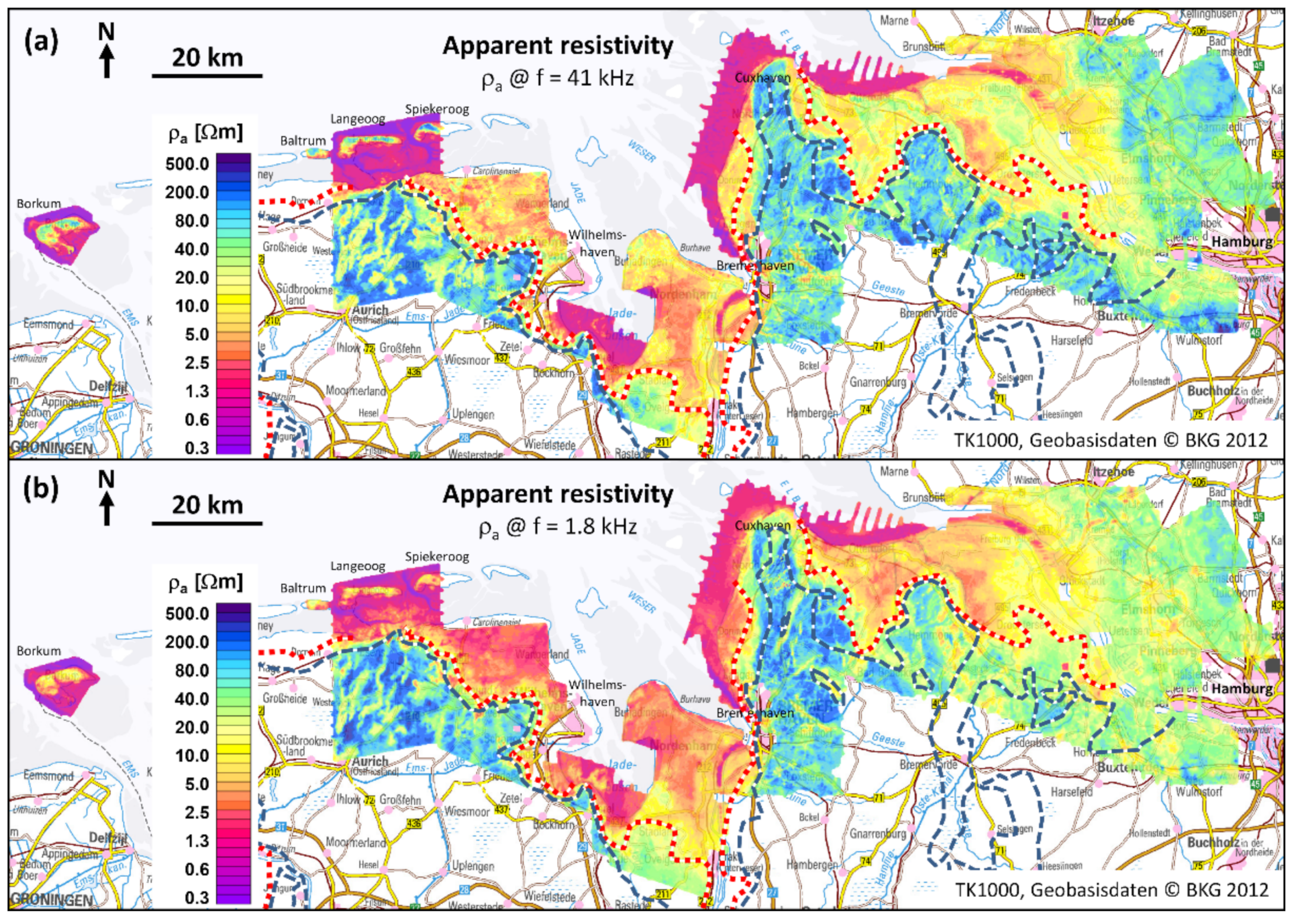


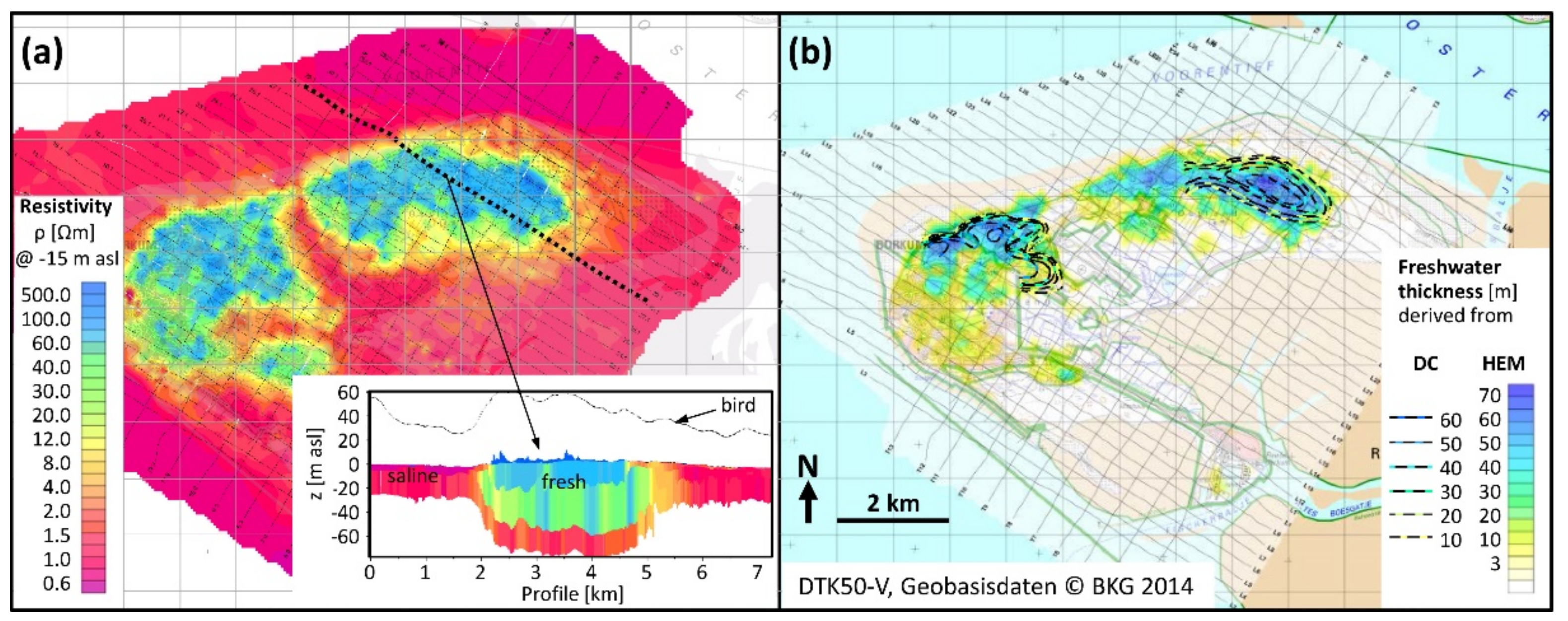

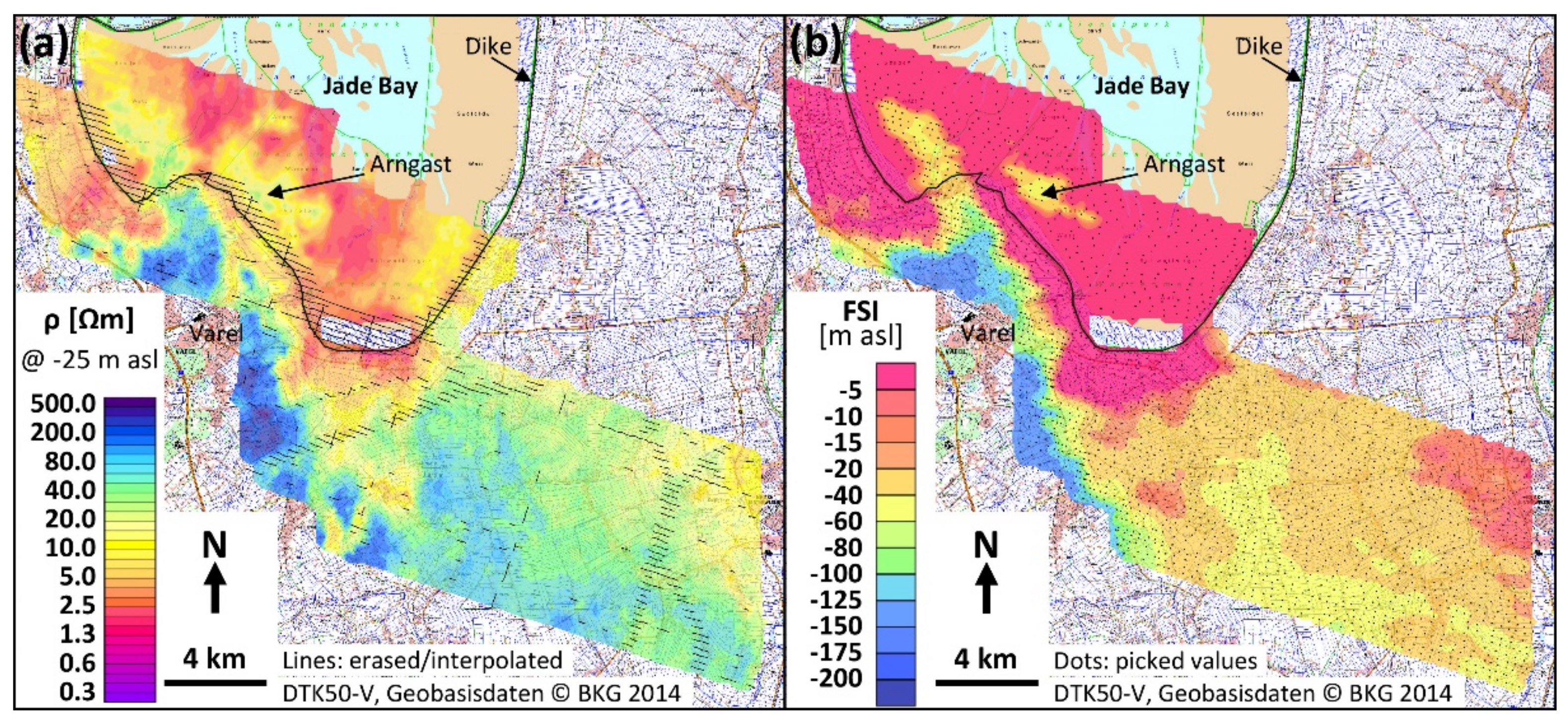
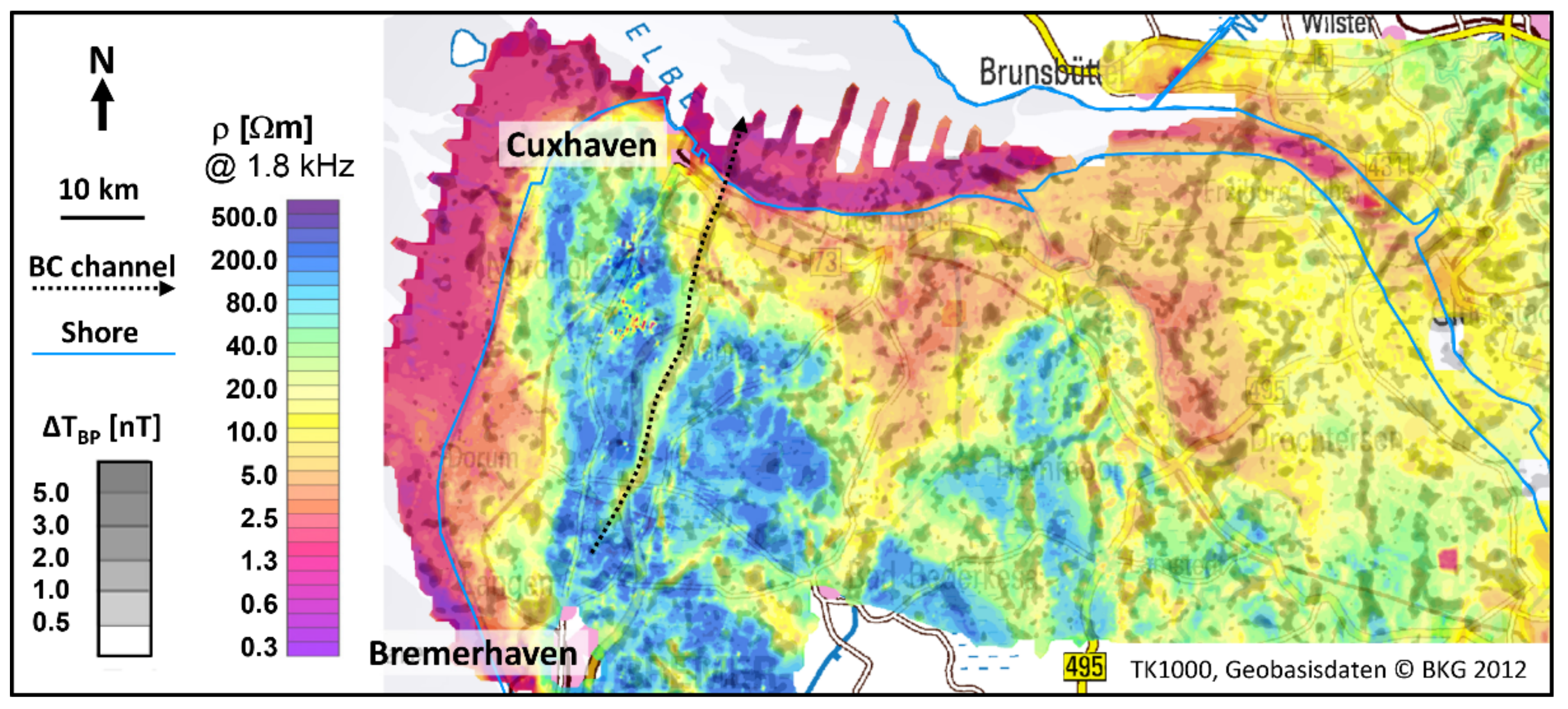



| System No. | HEM Bird No. (Freq.) | HMG Cs Magnetometer | HRD Spectrometer/Crystal Pack |
|---|---|---|---|
| 1 | BKS48 (5F) | G-822A | GR-820/GPX-1024 (4⨯4 L) |
| 2 | BKS36a (5F) | G-822A | GR-820/GPX-1024 (5⨯4 L) |
| 3 | BKS60 (5F) | G-822A | GR-820/GPX-1024 (5⨯4 L) |
| 4 | BKS36a (6F) | G-822A | GR-820/GPX-1024 (5⨯4 L) |
| 5 | BKS36a (6F) | G-822A | RS-500/RSX-5 (5⨯4 L) |
| 6 | BKS60 (6F) | G-822A | RS-500/RSX-5 (5⨯4 L) |
| Area No. | Area Name | Year | Area Size [km2] | Profile Length [km] | System No. |
|---|---|---|---|---|---|
| 081 | Cuxhaven | 2000 | 530 | 2427 | 1 |
| 087 | Bremerhaven | 2001 | 550 | 2227 | 1 |
| 109 | Hadelner Marsch | 2004 | 700 | 2971 | 3 |
| 111 | Ellerbeker Rinne | 2005/06 | 280 | 908 | 3 (2) |
| 128 | Langeoog | 2008/09 | 259 | 1081 | 4 |
| 129 | Esens | 2008/09 | 379 | 1542 | 4 |
| 130 | Borkum | 2008 | 88 | 414 | 4 1 |
| 132 | Glückstadt | 2008/09 | 1950 | 8581 | 4 (3) |
| 133 | Jever | 2009/14 | 490 | 2139 | 6 (4) |
| 138 | Nordenham | 2009/10 | 368 | 1569 | 4 |
| 139 | Varel | 2014 | 319 | 1245 | 6 |
| 149 | Langeoog 2 | 2014 | 10 | 39 | 5 |
| 155 | Baltrum | 2014 | 5 | 17 | 5 |
© 2020 by the authors. Licensee MDPI, Basel, Switzerland. This article is an open access article distributed under the terms and conditions of the Creative Commons Attribution (CC BY) license (http://creativecommons.org/licenses/by/4.0/).
Share and Cite
Siemon, B.; Ibs-von Seht, M.; Steuer, A.; Deus, N.; Wiederhold, H. Airborne Electromagnetic, Magnetic, and Radiometric Surveys at the German North Sea Coast Applied to Groundwater and Soil Investigations. Remote Sens. 2020, 12, 1629. https://doi.org/10.3390/rs12101629
Siemon B, Ibs-von Seht M, Steuer A, Deus N, Wiederhold H. Airborne Electromagnetic, Magnetic, and Radiometric Surveys at the German North Sea Coast Applied to Groundwater and Soil Investigations. Remote Sensing. 2020; 12(10):1629. https://doi.org/10.3390/rs12101629
Chicago/Turabian StyleSiemon, Bernhard, Malte Ibs-von Seht, Annika Steuer, Nico Deus, and Helga Wiederhold. 2020. "Airborne Electromagnetic, Magnetic, and Radiometric Surveys at the German North Sea Coast Applied to Groundwater and Soil Investigations" Remote Sensing 12, no. 10: 1629. https://doi.org/10.3390/rs12101629






